An Examination of Stream Water Quality Data from Monitoring of Forest Harvesting in the Eastern Highlands of Victoria
Abstract
:1. Introduction
1.1. The Central Highlands of Victoria
1.2. Forest Harvesting in the Central Highlands
- Lidar examination of areas and “recovery” of existing but overgrown logging roads to avoid earthworks where possible. Where possible, old roads are located, the vegetation removed, and the road formation reused.
- Protection of active streams with a riparian buffer of 20 m width from the stream edge. No trees are removed from these areas and roads and tracks do not penetrate the buffer zone. This gives an “infiltration zone” to absorb road and track runoff and protects the stream from insolation. Amongst others, refs. [7,8,9] give overviews of the efficacy of buffers in protecting water quality.
- Avoidance of large, exposed areas. In recent years, “variable retention harvesting” has been used. This ensures that more than 50% of a harvesting area is within one tree height of the retained forest, or that “islands” of trees are retrained within larger contiguous areas.
- Careful road layout to ensure roads are kept away from streams as far as possible; this reduces a major source of pollution [10].
- Avoidance of forestry work during prolonged wet weather.
- Avoidance of large accumulations of organic debris, usually by scattering this through the forest areas. This is for both fire and water quality protection, and to avoid off-site nutrient loss.
- Use of a “landing” for most works of storing and processing logs and other products. The site of the landing is marked to be well away from streams and water courses. The landing is well-drained with runoff passing into an “infiltration area”. At the cessation of logging, the landing is usually “rehabilitated” by ripping to remove compaction. Occasionally landings will be planted with local tree species to ensure regeneration but more commonly this is not needed.
- Strict supervision of works to ensure compliance with the many provisions of the Victorian Government’s “Code of Forest Practice”.
1.3. Water Quality Standards
- Low values of water turbidity. Ideally, samples should have <5 NTU turbidity. In such streams, turbidity can be used as a general measure of sediment and soil contamination [18]. In general, there is a positive correlation between turbidity and parameters such as sediment load or water colour, but the actual regression differs from catchment to catchment. This is due to increased particulates being the usual cause of increased turbidity. It is known that much of the material causing increased turbidity is finely divided organic matter and hence increased turbidity may well be associated with decreased stream oxygen content [19].
- Temperature of streams between 5 °C and 15 °C. These two ranges mark the “lowest” and “highest” temperature (defining an optimal range) of a small mountain fish (Galaxias fuscus—Barred Galaxias). These fish inhabit small, shallow, gravel-bottomed streams in mountainous areas. It has been hypothesised that, at higher temperatures, water may not carry enough oxygen to sustain fish life.
- Dissolved oxygen (DO) levels of >3 mg/L. This is viewed as the minimum DO for Barred Galaxias. In general, the streams from this mountain area flow over bedrock with a high gradient and many “white-water micro-rapids”, so the streams are highly oxygenated. The “white-water” represents entrainment of air in the flowing water. It has been shown that small headwater streams often have a diurnal variation in oxygen levels [20], and this can be an additional source of measurement error.
1.4. Advantages and Disadvantages of Water-Quality-Monitoring Networks
2. Methods
2.1. Data Measurement
2.2. Parameters and the Data Set
- Nephelometric turbidity (NTU units). This is a general measure of the suitability of water for drinking, with an NTU <5 indicating highly potable water. It is an optical measure given by the ratio of scattered-to-direct light transmission when a beam of light is passed into the water. Active streams are very dynamic in turbidity changes, with rain events giving transient higher turbidity early in the storm response hydrograph [18]. In general, the streams in this environment are “sediment-limited” and the turbidity response to rainfall quickly dissipates as available sediment moves downstream.
- Dissolved oxygen (“DO”) content (mg/L). In general, highly oxygenated streams support more in-stream biomass. Passage of stream water through large masses of decomposing vegetation can give a low oxygen content but such dumping of organic matter in streams is precluded by the terms of logging prescriptions and the “Code of Practice for Timber Production 2014” [25]. A priori, most streams in the data set from the “Logged” and the “Unlogged” groups would be expected to have a high oxygen content because of their high channel gradient and the resultant turbulence (which entrains oxygen). The minimum DO desirable for Barred Galaxias is 3 mg L−1 [26].
- Stream temperature. Barred Galaxias ideally should have a stream water temperature between 5 °C and 15 °C. The removal of streamside vegetation by logging can possibly increase stream insolation, increasing the temperature. It has been shown that although the riparian buffer strips protect the streams from direct insolation, “sidelight” from outside the buffer strips can increase light intensity [7]. This possibly may lead to small, local increases in stream temperature.
- Catchment areas and areas of logging within the sampled catchments provided by VicForests staff using Victorian topographic mapping and their forest management records.
- Streams or rivers with forested catchments and logging upstream of the sampling point (“Logged Catchments”). There were 19 such sampling points.
- Streams or rivers with forested catchments and no logging upstream of the sampling points (“Unlogged catchments”). Some of these areas do have small farm holdings embedded in the forest. There were 13 such sampling points.
- Streams or rivers referred to by community members as “needing to be protected”—“Community Reference Points”. Commonly these had areas of agriculture (grazing and cultivation) and farms upstream or in the vicinity of the sampling points. There were 9 such sampling points.
2.3. Examination of Frequency Distributions
2.4. Data Transformations and Hypothesis Testing
2.5. Spearman Correlation Examination of Parameters
2.6. Comparison of Means with Reference Points
3. Results
3.1. Annual Distributions
3.2. Frequency Analysis
3.3. Hypothesis Testing
3.4. Spearman Correlation Examination of Parameters
3.5. Comparison of Reference Sites with Forested Sites
- Figure 12 (turbidity) shows the poor water quality associated with the Yea River (two sites) and, to a lesser extent, the Yarra River (outside of Melbourne’s catchment areas), the Goulburn River (at Alexandra), and the Acheron River. Each of these has substantial cultivation or other agricultural pursuits close to the water body. One can also find examples of small landslips associated with loss of riparian vegetation. The Campbells Creek data (unlogged forest) also show turbidity impairment; it is thought that this is associated with a small area of agricultural land within the forest.
- The Goulburn River at “Walnut Reserve” and Alexandra shows lower levels of dissolved oxygen than the forested sites (Figure 13).
- In general, the forested catchments show lower stream temperatures than the “Reference Sites” (Figure 14). This is likely to be associated with the cooling effect of forest transpiration and the loss of riparian vegetation in the larger rivers.
4. Discussion
5. Conclusions
Supplementary Materials
Author Contributions
Funding
Data Availability Statement
Acknowledgments
Conflicts of Interest
References
- Indigenous Elder Stresses Importance of Snobs Creek—Friends of the Earth Melbourne (melbournefoe.org.au). Available online: https://www.melbournefoe.org.au/indigenous_elder_stresses_importance_of_snobs_creek (accessed on 30 June 2024).
- Wilderness Society | Barred Galaxias (Vic). Available online: https://www.wilderness.org.au/news-events/barred-galaxias-vic (accessed on 30 June 2024).
- Inbar, A. The Role of Fire in the Coevolution of Vegetation, Soil, and Landscapes in Southeastern Australia. Ph.D. Thesis, The University of Melbourne, Parkville, Australia, 2017. [Google Scholar]
- Van der Sant, R.E.; Nyman, P.; Noske, P.J.; Langhams, C.; Lane, P.N.; Sheridan, G.J. Quantifying relations between surface runoff and aridity after wildfire. Earth Surf. Process. Landf. 2018, 43, 2033–2044. [Google Scholar] [CrossRef]
- Bren, L.J. Hydrologic impacts of fire on the Croppers Creek paired catchment experiment. In Revisiting Experimental Catchment Studies in Forest Hydrology; Proceedings of a Workshop held during the XXV IUGG General Assembly in Melbourne, June–July 2011; IAHS Publication 353: Orlando, FL, USA, 2011; pp. 154–165. [Google Scholar]
- Evans, P. Wooden Rails and Green Gold: A Century of Timber and Transport along the Yarra Track; Light Railway Research Society of Australia Inc.: Melbourne, Australia, 2022. [Google Scholar]
- Dignan, P.; Bren, L.J. A Study of the Effects of Logging on the Understorey Light Environment in Riparian Buffer Strips in a South-East Australian Forest. For. Ecol. Manag. 2003, 180, 110–121. [Google Scholar] [CrossRef]
- Bisson, P.A.; Claeson, S.M.; Wondzell, S.M.; Forster, A.D.; Steel, A.L. Evaluating Headwater Stream Buffers: Lessons Learned from Watershed Scale Experiments in Southwest Washington; General Technical Report, Pacific Northwest Resource Station, US Forest Service; U.S. Department of Agriculture Forest Service: Washington, DC, USA, 2013.
- Sweeney, B.W.; Newbold, J.D. Streamside Forest Buffer Width Needed to Protect Stream Water Quality, Habitat, and Organisms: A Literature Review. J. Am. Water Resour. Assoc. 2014, 50, 560–584. [Google Scholar] [CrossRef]
- Lane, P.N.; Sheridan, G.J. Impact of an Unsealed Forest Road Stream Crossing: Water Quality and Sediment Source. Hydrol. Process. 2002, 16, 2599–2612. [Google Scholar] [CrossRef]
- Flint, A.; Fagg, P.C. Mountain Ash in Victoria’s State Forests. Silviculture Reference Manual No. 1; Department of Sustainability and Environment: Melbourne, Australia, 2007; 97p. [Google Scholar]
- Sebire, I.; Fagg, P.C. High Elevation Mixed Species in Victoria’s State Forests; Department of Sustainability and Environment: Melbourne, Australia, 2009; 112p. [Google Scholar]
- Grayson, R.B.; Haydon, S.R.; Jayasuriya, D.A.; Finlayson, B.L. Water Quality in Mountain Ash Forests—Separating the Impacts of Roads from Those of Logging Operations. J. Hydrol. 1993, 150, 459–480. [Google Scholar] [CrossRef]
- Reid, L.M.; Dunne, T. Sediment Production from Forest Road Surfaces. Water Resour. Res. 1984, 20, 1753–1761. [Google Scholar] [CrossRef]
- Sheridan, G.J.; Noske, P.J.; Whipp, R.K.; Wijesinghe, N. The Effect of Truck Traffic and Road Water Content on Sediment Delivery from Unpaved Forest Roads. Hydrol. Process. Int. J. 2006, 20, 1683–1699. [Google Scholar] [CrossRef]
- Georgiev, K.B.; Beudert, B.; Bässler, C.; Feldhaar, H.; Heibl, C.; Karasch, P.; Müller, J.; Perlík, M.; Weiss, I.; Thorn, S. Forest Disturbance and Salvage Logging Have Neutral Long-Term Effects on Drinking Water Quality but Alter Biodiversity. For. Ecol. Manag. 2021, 495, 119354. [Google Scholar] [CrossRef]
- Jobson, H.E. Prediction of Travel Time and Longitudinal Dispersion in Rivers and Streams; US Geological Survey: Reston, VA, USA, 1996; 69p.
- Bren, L.J. Forest Hydrology and Catchment Management: An Australian Perspective, 2nd ed.; Springer: Berlin, Germany, 2023; 416p. [Google Scholar]
- Hopmans, P.; Bren, L.J. Long-Term Changes in Water Quality and Solute Exports in Headwater Streams of Intensively Managed Radiata Pine and Natural Eucalypt Forest Catchments in South-eastern Australia. For. Ecol. Manag. 2007, 253, 244–261. [Google Scholar] [CrossRef]
- Ulseth, A.J.; Hal, R.O.; Canadell, M.L.; Madinger, H.L.; Niayifar, A.; Battin, T.J. Distinct Air-Water Gas Exchange Regimes in Low and High Energy Streams. Natl. Geosci. 2019, 12, 259–263. [Google Scholar] [CrossRef]
- MacDonald, L.H.; Smart, A.W.; Wissmar, R.C. Monitoring Guidelines to Evaluate the Effects of Forestry Activities on Streams in the Pacific Northwest and Alaska; University of Washington Water Centre: Seattle, WA, USA, 1991. [Google Scholar]
- MacDonald, L.H.; Smart, A.W. Beyond the Guidelines: Practical Lessons for Monitoring. Environ. Monit. Assess. 1993, 26, 203–218. [Google Scholar] [CrossRef] [PubMed]
- NHMRC. Australian Drinking Water Guidelines.6, Version 3.8, Updated September 2022; National Health and Medical Research Council: Canberra, Australia, 2011.
- Water Quality: Products for Stand-Alone Water Quality Monitoring. (campbellsci.com.au). Available online: https://www.campbellsci.com.au/?gad_source=1&gclid=CjwKCAjw65-zBhBkEiwAjrqRMC0rJRMzgdyCIQS80eAFAu4gX_vOWJlU_P_weuQsVjK10rbhVuRlExoCzhMQAvD_BwE (accessed on 30 June 2024).
- DEECA. Code of Practice for Timber Production 2014; Amended to 2022; Department of Energy, Environment, and Climate Action: Melbourne, Australia, 2022. [Google Scholar]
- Raadik, T.A.; Fairbrother, P.S.; Smith, S.J. National Recovery Plan for the Barred Galaxias Galaxias fuscus; Department of Sustainability and Environment: Melbourne, VIC, Australia, 2010; 21p. [Google Scholar]
- Helsel, D.R.; Hirsch, R.M. Statistical Methods in Water Resources. In Studies in Environmental Science; Elsevier: Amsterdam, The Netherlands, 2020; Volume 49. [Google Scholar]
- Van Buren, M.A.; Watt, W.E.; Marsalek, J. Application of the Log-Normal and Normal Distributions to Stormwater Quality Parameters. Water Res. 1997, 31, 95–104. [Google Scholar] [CrossRef]
- Steel, R.G.; Torrie, J.H. Principles and Procedures of Statistics: A Biometrical Approach, 2nd ed.; McGraw Hill Kogakusha: New Delhi, India, 1981; 633p. [Google Scholar]
- Smith, H.G.; Sheridan, G.J.; Lane, P.N.; Nyman, P. Wildfire Effects on Water Quality in Forest Catchments; a Review with Implications for Water Supply. J. Hydrol. 2011, 396, 170–192. [Google Scholar] [CrossRef]
- Mossop, D.C.; Kellar, K.; Jeppe, K.; Myers, J.; Rose, G.; Weatherman, K.; Pettigrove, V.; Leahy, P. Impacts of Intensive Agriculture and Plantation Forestry on Water Quality in the La Trobe Catchment; EPA Victoria Publication: Melbourne, VIC, Australia, 2013. [Google Scholar]
- Hewlett, J.D.; Lull, H.W.; Reinhart, K.G. In Defense of Experimental Watersheds. Water Resour. Res. 1969, 5, 306–316. [Google Scholar] [CrossRef]
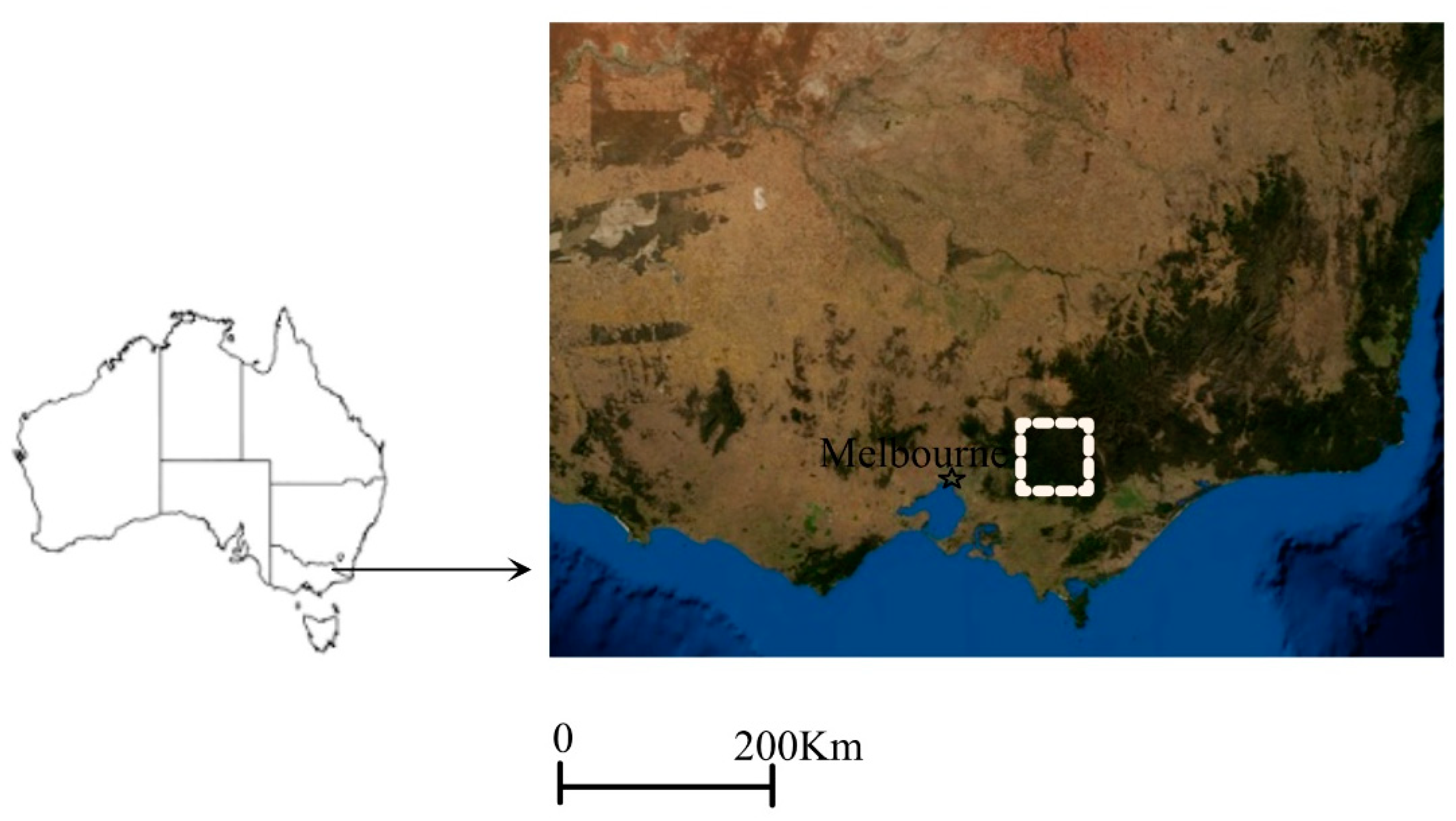
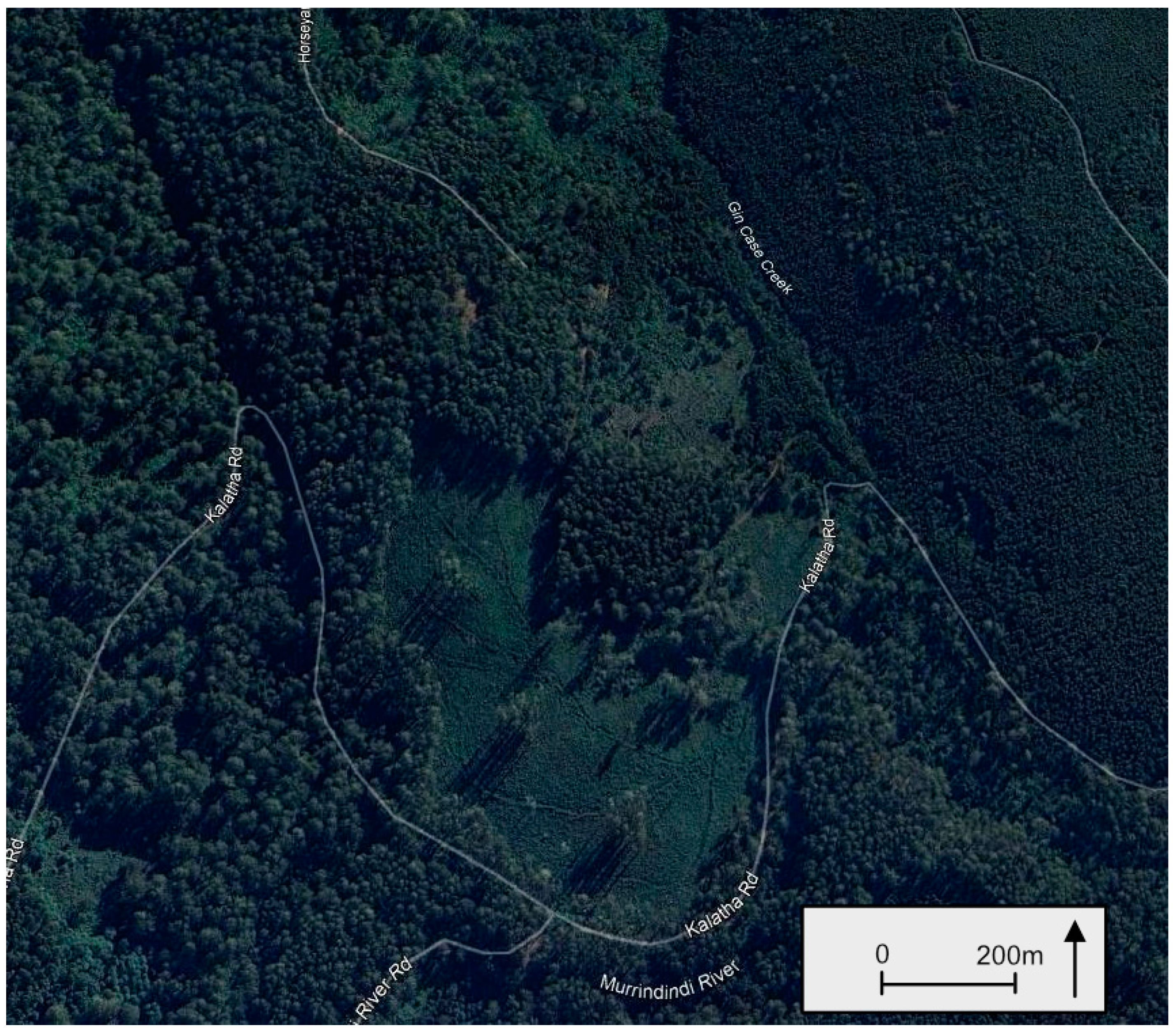
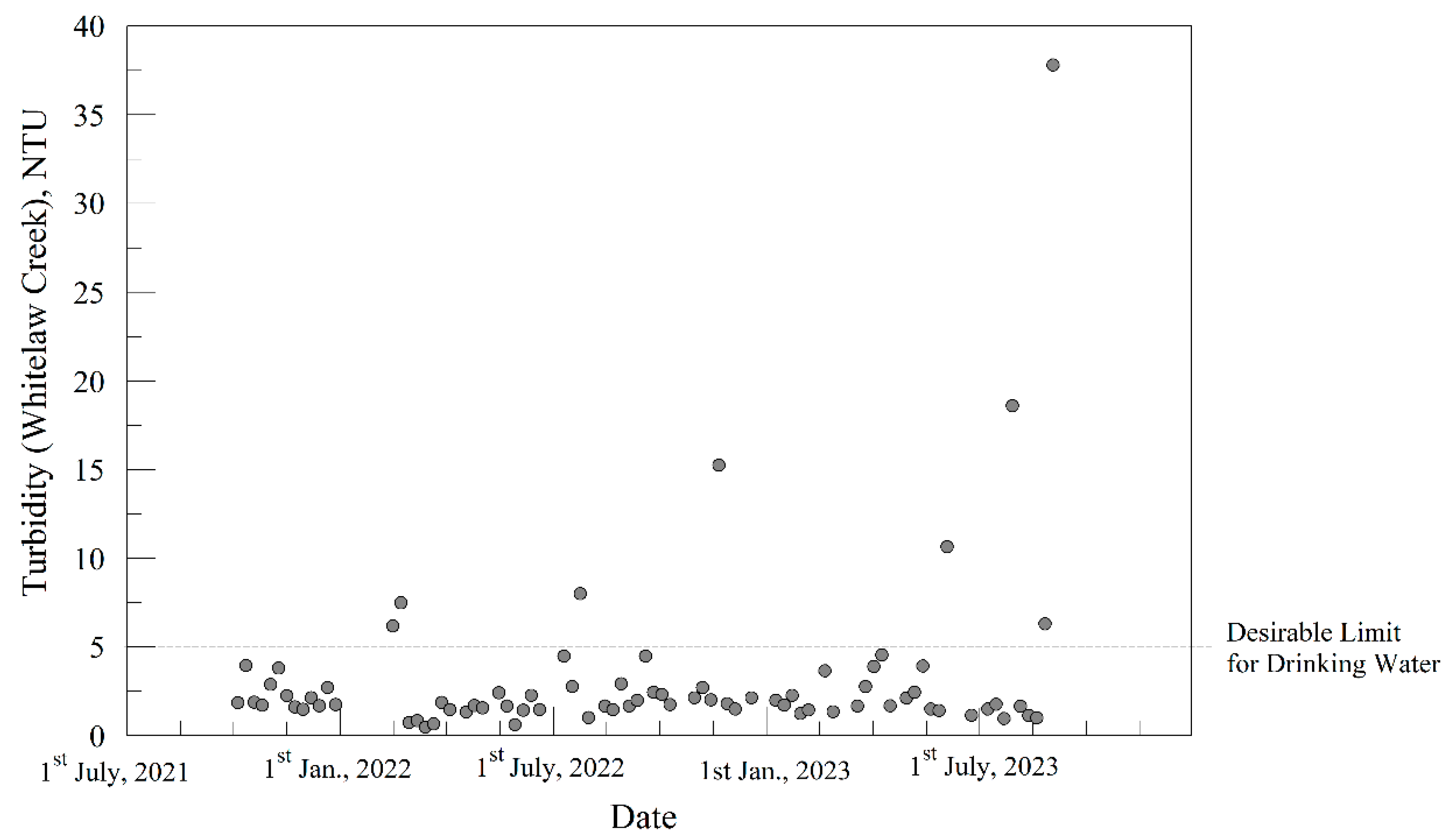
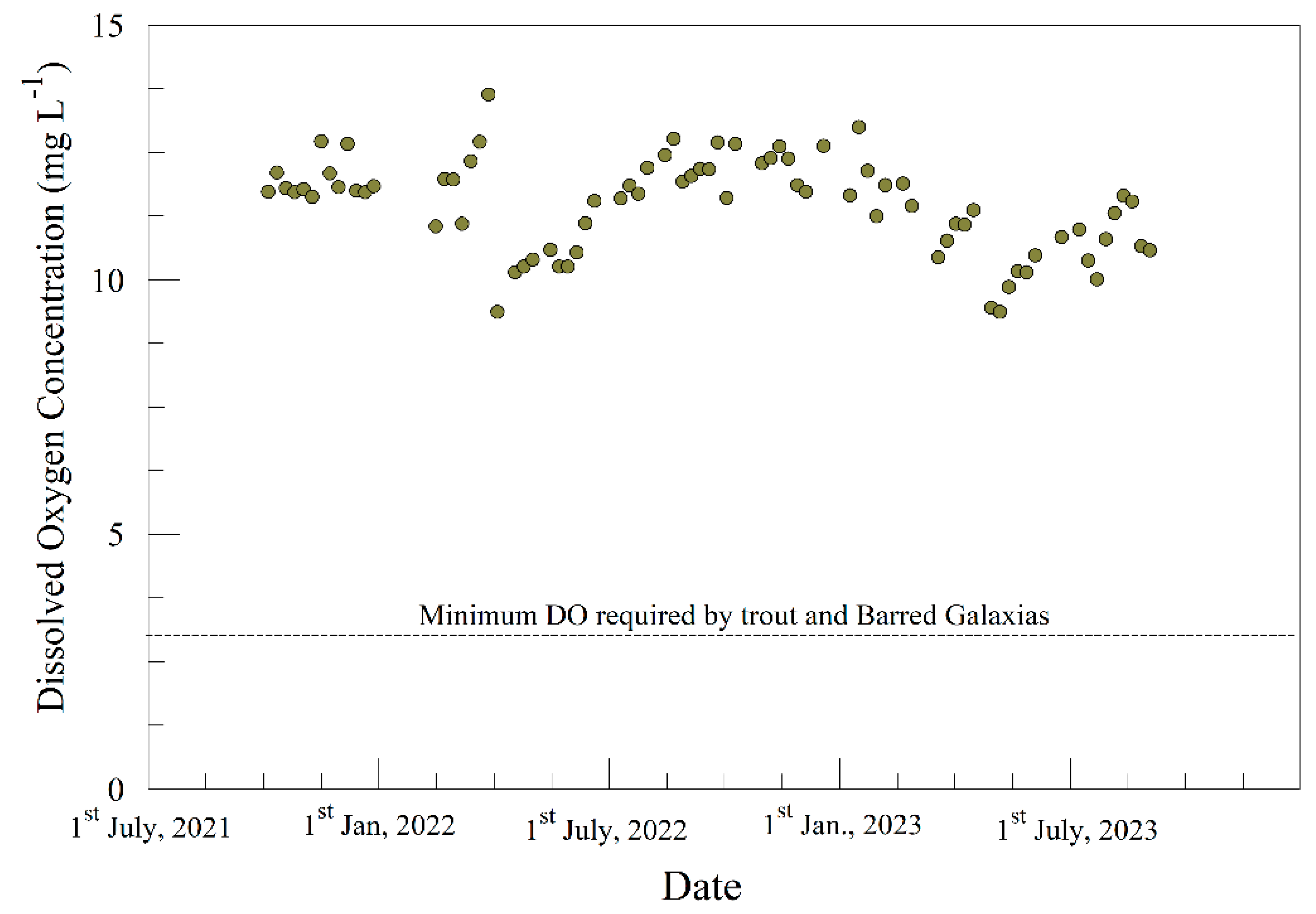
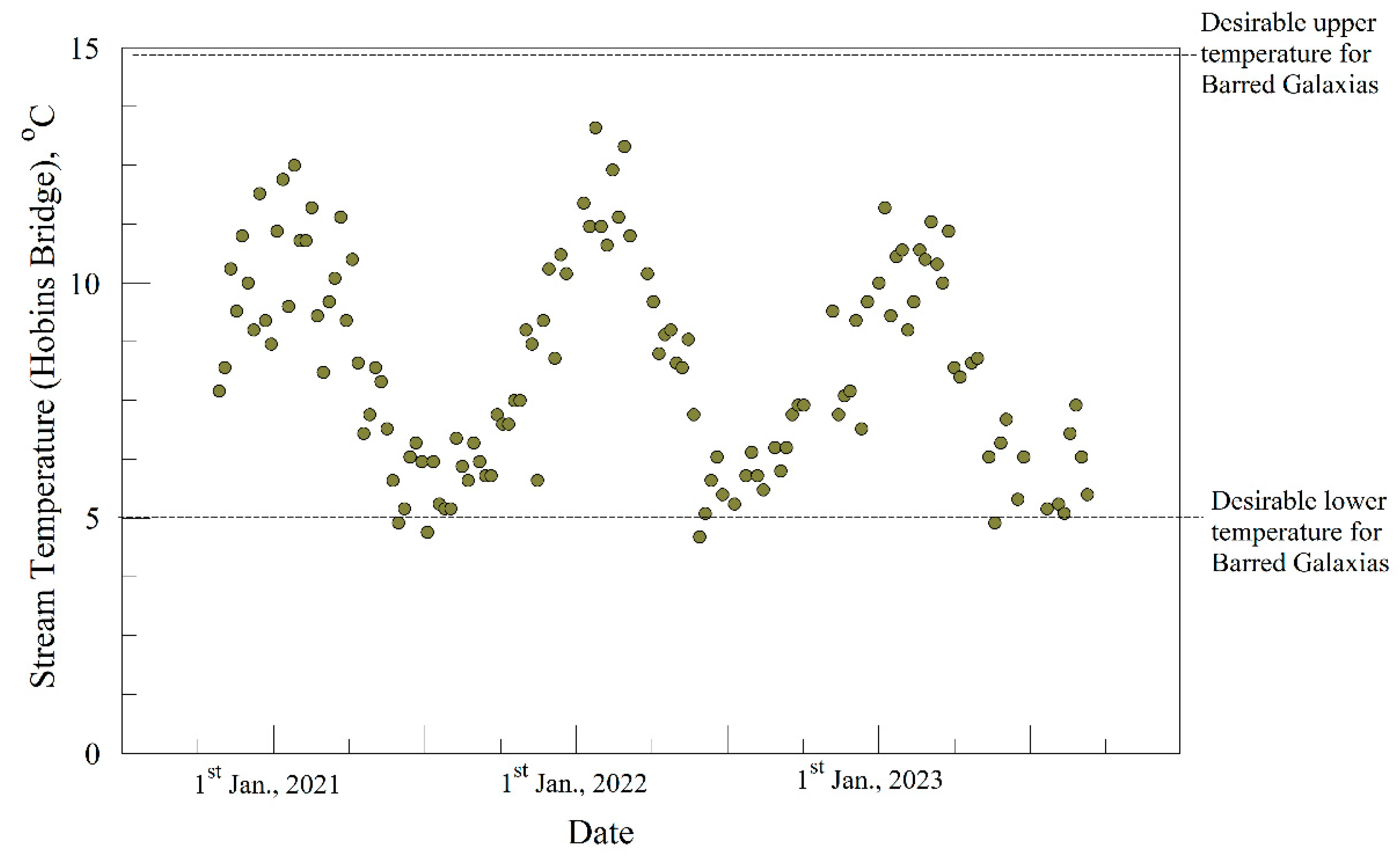
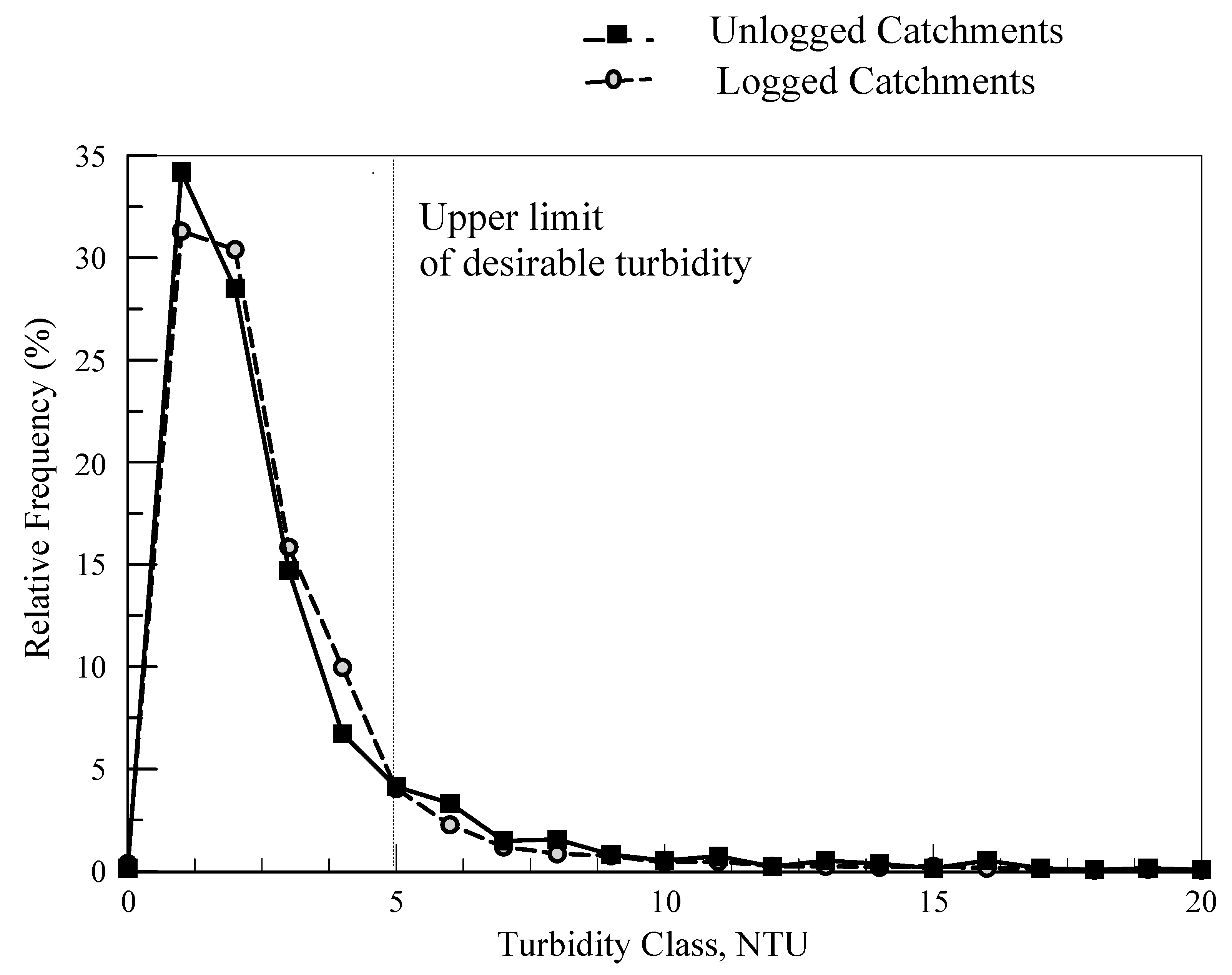
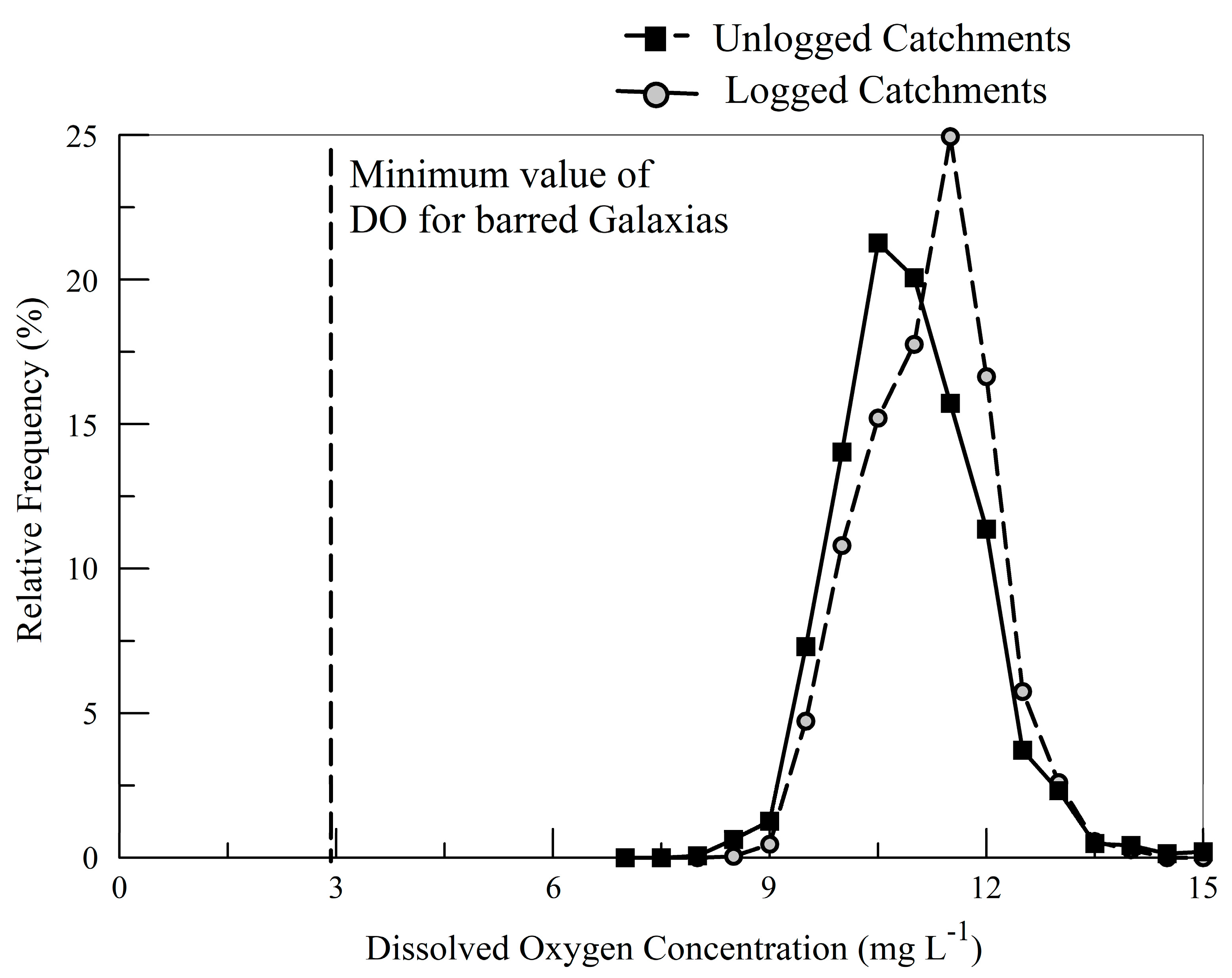

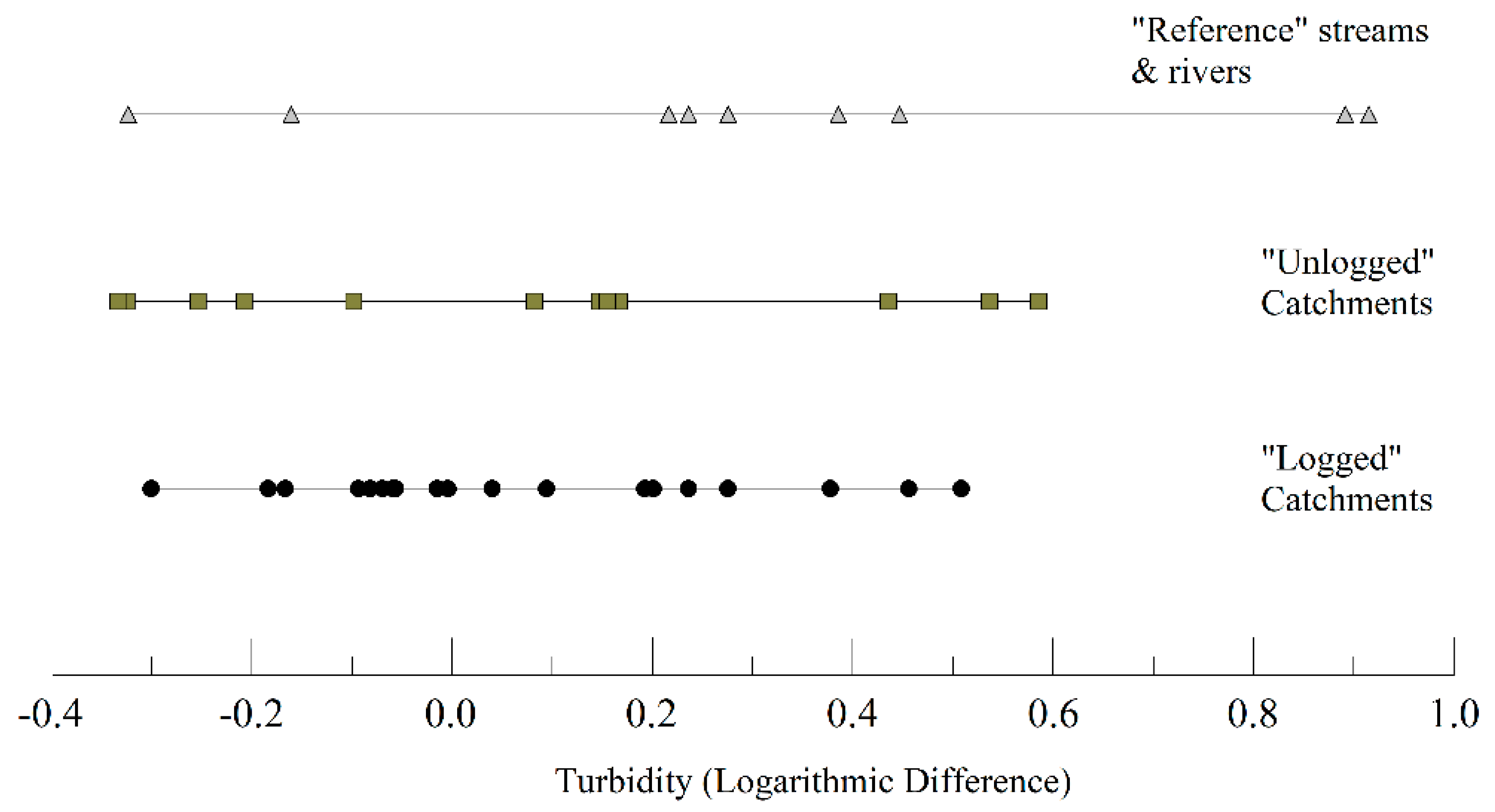
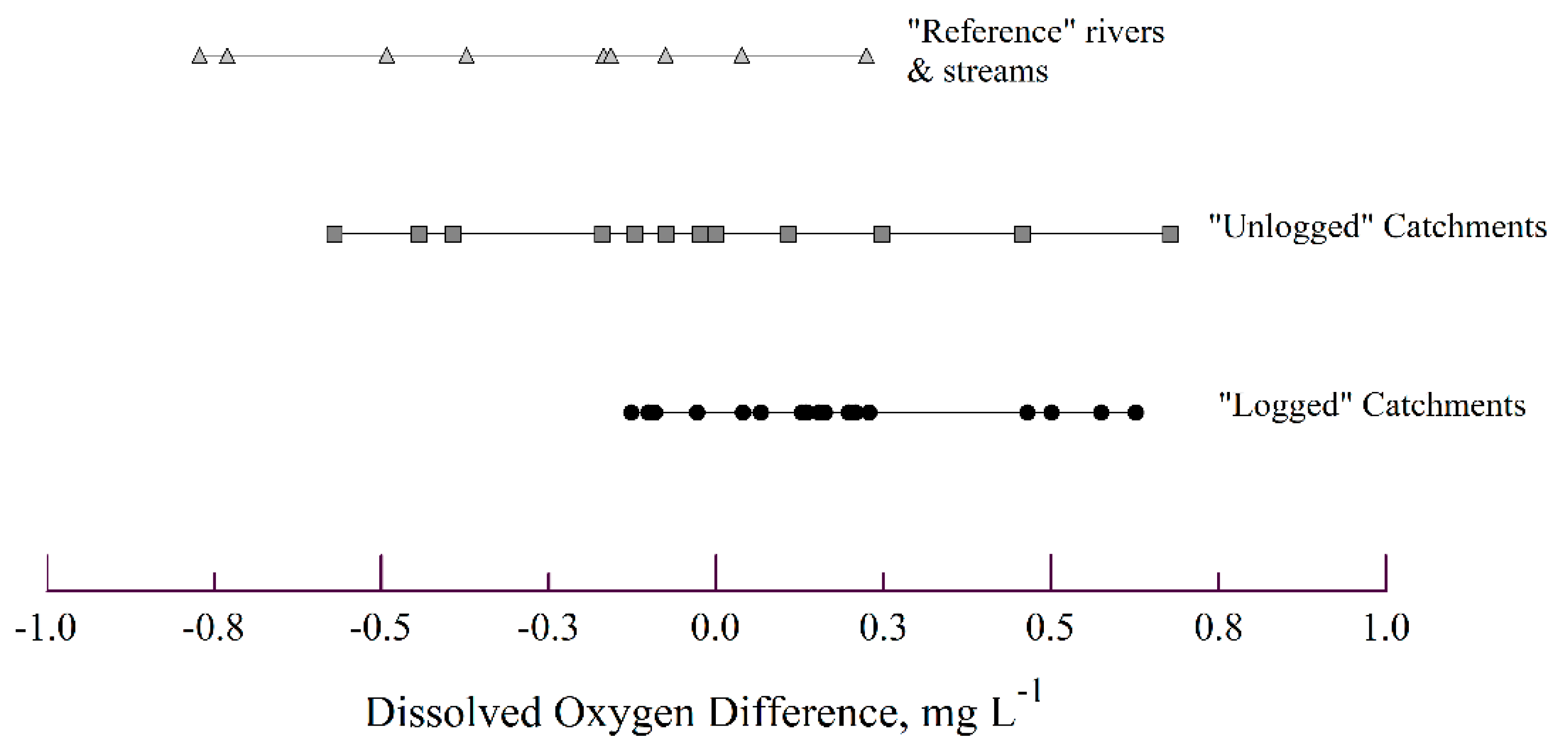

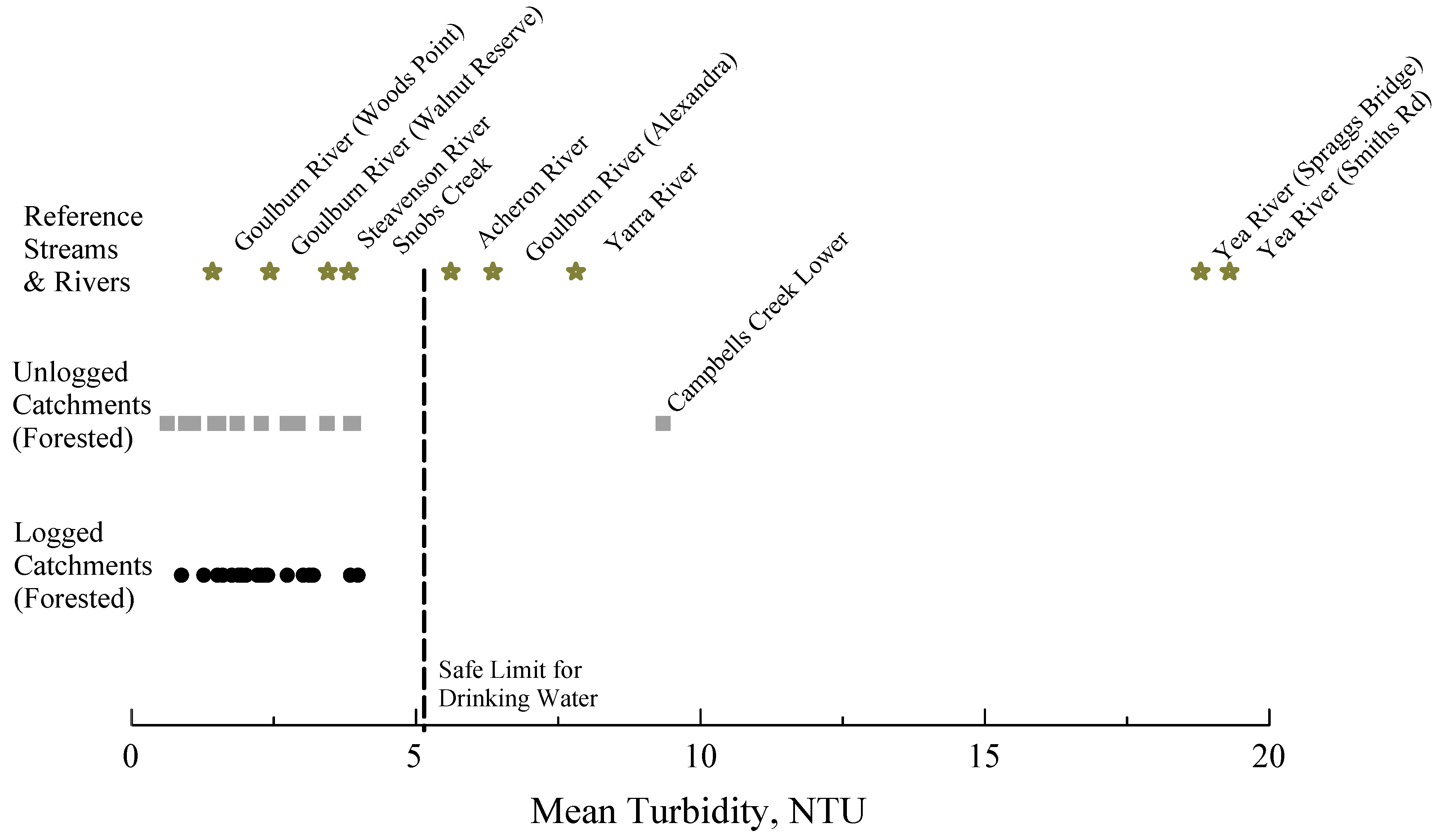
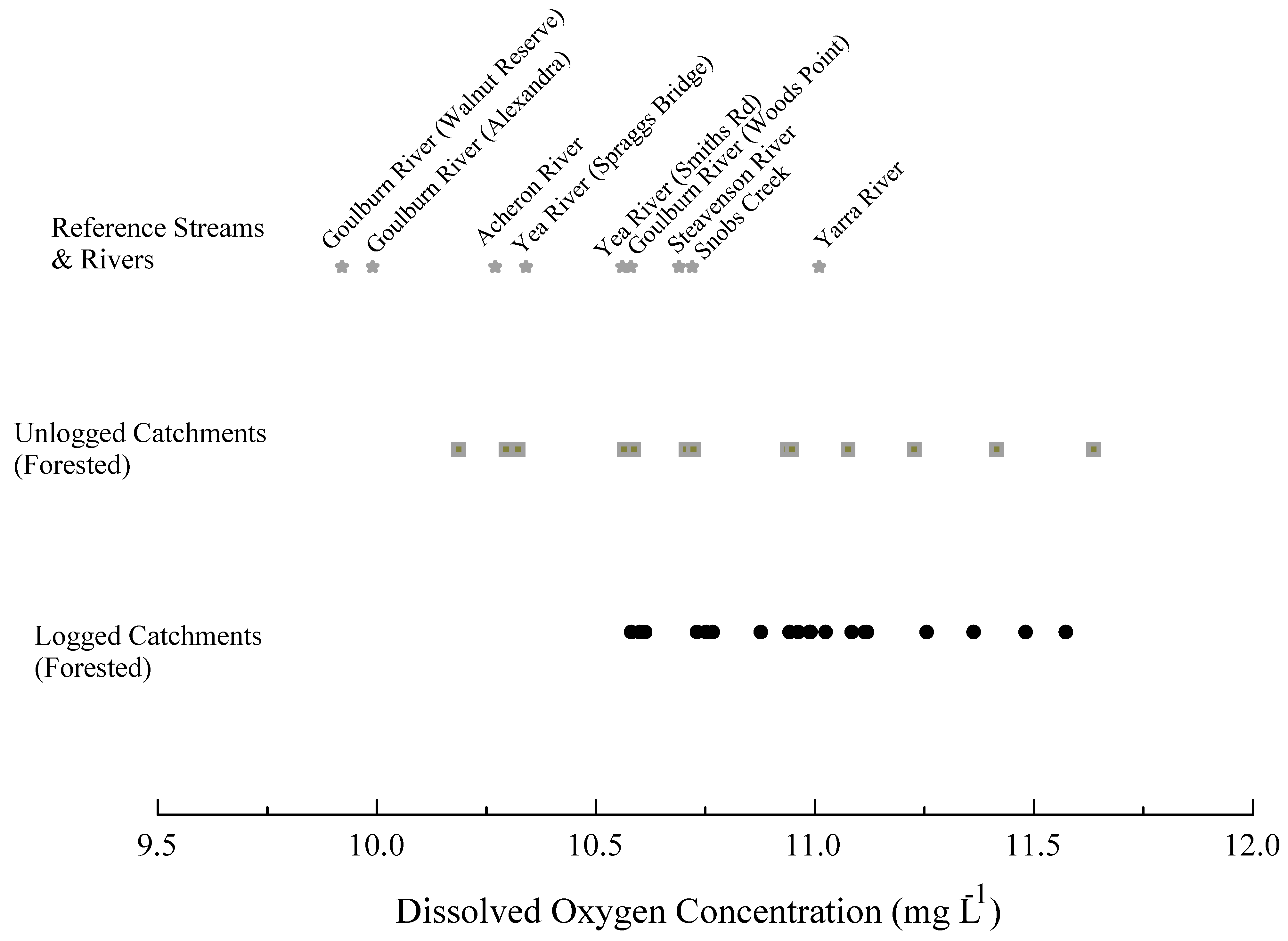

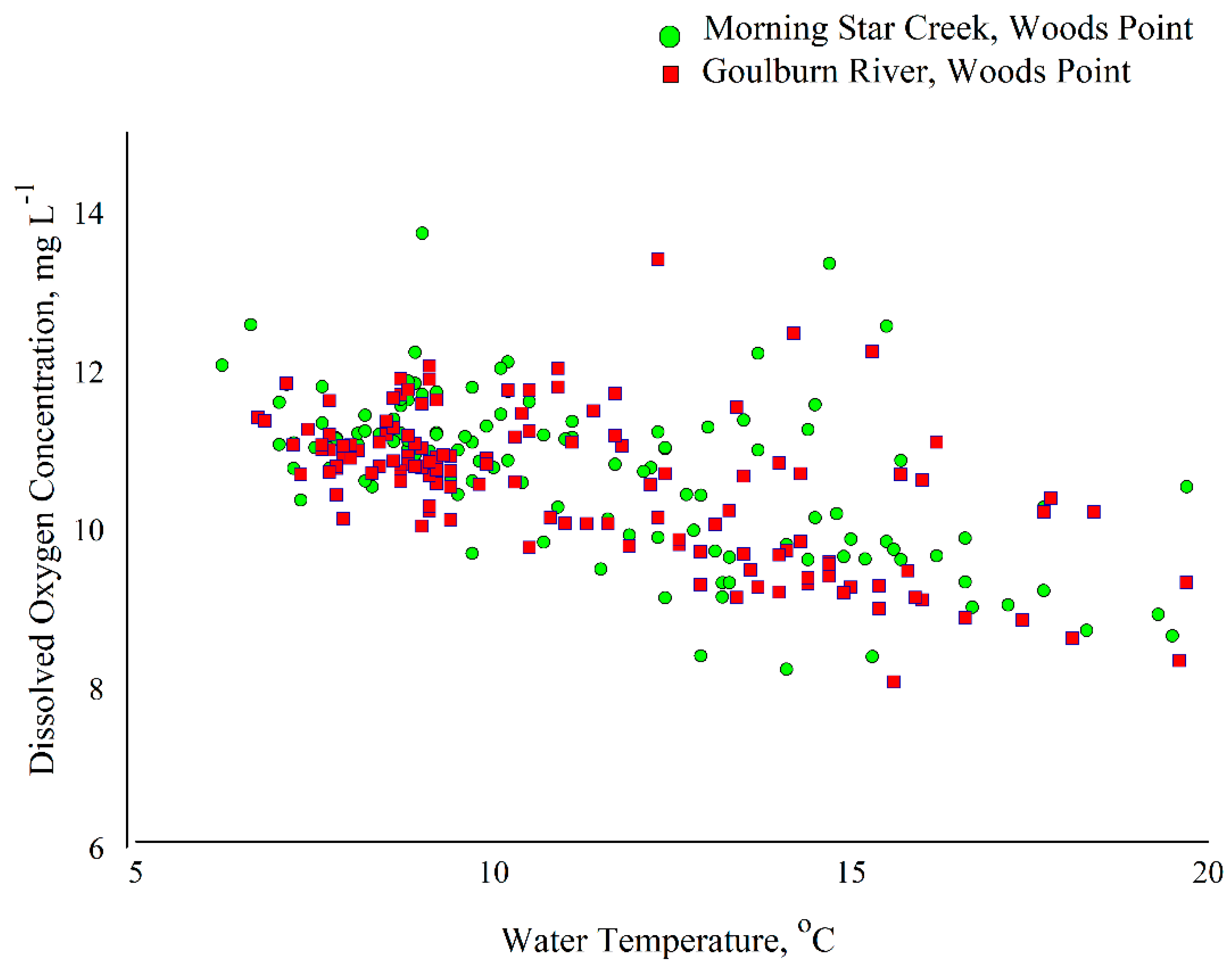
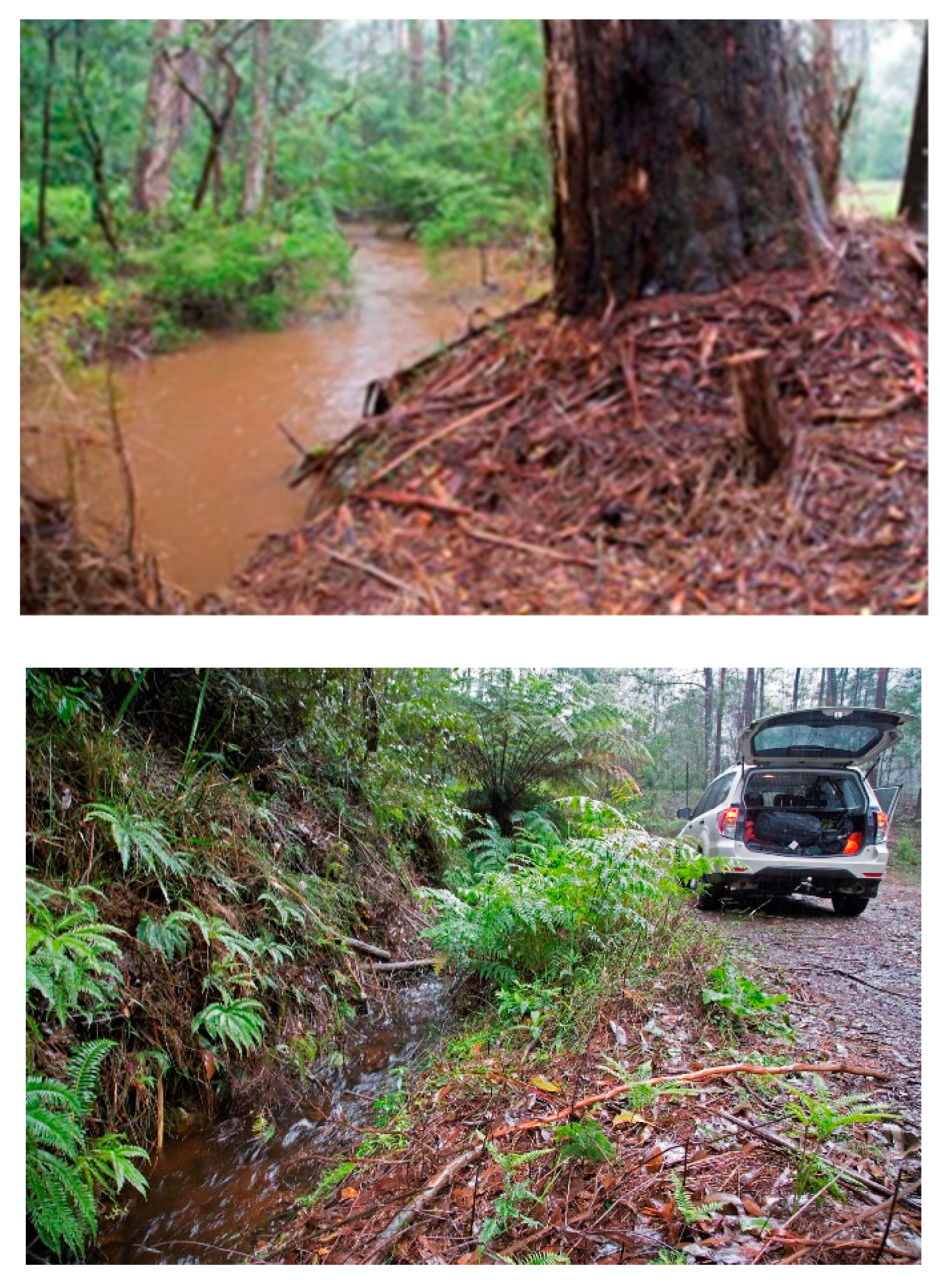
| Name (and Group) | Catchment | Logged | Land Use | Years Logged |
|---|---|---|---|---|
| Area | Area | |||
| Ha | Ha | |||
| Logged Group | ||||
| Arnold Middle | 2335 | 24.2 | F, L | 2017–2020 |
| Arnold Lower | 3101 | 23.7 | F, L | 2017–2021 |
| Torbreck River | 2933 | 17.6 | F, L | 2020–2022 |
| Koala Upper | 830 | 9.0 | F, L | 2021–2022 |
| Koala Lower | 1866 | 8.7 | F, L | 2020 |
| Petty Metal Creek | 455 | 10.5 | F, L | 2020–2022 |
| Oaks Creek | 6900 | 13.0 | F, L | 2017–2022 |
| Springs Creek | 4106 | 202.4 | F, L | 2017–2022 |
| Matlock Creek | 3868 | 162.7 | F, L | 2020–2021 |
| Jordan Lower | 4960 | 32.6 | F, L | 2021 |
| Poole Gully | 413 | 23.3 | F, L | 2021 |
| BB Lower | 1137 | 29.0 | F, L | 2020–2023 |
| Whitelaw Creek | 3976 | 4.1 | F, L | 2020 |
| Eastern Outflow | 12,720 | 5.4 | F, L | 2021 |
| Dry Creek | 3615 | 39.9 | F, L | 2019–2021 |
| No. 6 Bridge | 2342 | 37.1 | F, L | 2018–2021 |
| Hobins Bridge | 1851 | 12.6 | F, L | 2019–2021 |
| Newmans Creek | 273 | 6.0 | F, L | 2021–2022 |
| No. 5 Bridge | 968 | 51.9 | F, L | 2019–2023 |
| Unlogged Group | ||||
| Arnold Upper | 339 | F | ||
| Jordan Upper | 3 | F | ||
| Folkes Creek | 7 | F | ||
| Whitelaw Upper | 1216 | F | ||
| Upper Thomson River | 1959 | F | ||
| Middle Thomson River | 11,992 | F | ||
| No. 6 Tributary | 163 | F | ||
| Coles Creek | 303 | F | ||
| Sylvia Creek | 662 | F | ||
| Campbells Creek Upper | 381 | F | ||
| Campbells Creek Lower | 815 | F | ||
| Yea River Yea Link | 489 | F | ||
| Morning Star Creek | 1123 | F | ||
| Community Reference Group | ||||
| (Agriculture) | ||||
| Goulburn River, Walnut Res | 374,896 | P | ||
| Acheron River | 50,498 | P | ||
| Goulburn River, Woods Point | 2527 | F | ||
| Goulburn River, Alexandra | 487,314 | P | ||
| Yarra River, O’Shannessy | P | |||
| Steavenson River | P | |||
| Snobs Creek, Goulburn Vally Hwy | 5055 | P | ||
| Yea River, Smiths Road | 2514 | A | ||
| Yea River, Spraggs Bridge | 3649 | A |
| Logged Catchments | Unlogged Catchments | |
|---|---|---|
| Turbidity | ||
| Mean | 2.4 NTU | 3.0 NTU |
| Std Dev. | 4.24 | 10.92 |
| Skewness | 12.96 | 18.86 |
| Count | 2108 | 1356 |
| Dissolved Oxygen | ||
| Mean | 11.0 mg L−1 | 10.8 mg L−1 |
| Std Dev. | 1.0 | 1.15 |
| Skewness | 2.82 | 2.24 |
| Count | 2170 | 1434 |
| Temperature | ||
| Mean | 9.4 °C | 9.8 °C |
| Std Dev. | 2.6 | 2.8 |
| Skewness | 0.37 | 0.29 |
| Count | 2187 | 1436 |
| “Student’s t” | Probability | Ho | |
|---|---|---|---|
| Value | |||
| Turbidity | −0.032 | 0.977 | Accept |
| Dissolved Oxygen | 1.161 | 0.155 | Accept |
| Temperature | −0.045 | 0.964 | Accept |
| Turbidity | DO | Temp. | Catchment Area | |
|---|---|---|---|---|
| DO | −0.33 | |||
| Temp | 0.02 | 0.09 | ||
| Catchment Area | 0.33 | 0.19 | 0.1 | |
| Logged Area | 0.01 | 0.33 | 0.08 | 0.53 * |
Disclaimer/Publisher’s Note: The statements, opinions and data contained in all publications are solely those of the individual author(s) and contributor(s) and not of MDPI and/or the editor(s). MDPI and/or the editor(s) disclaim responsibility for any injury to people or property resulting from any ideas, methods, instructions or products referred to in the content. |
© 2024 by the authors. Licensee MDPI, Basel, Switzerland. This article is an open access article distributed under the terms and conditions of the Creative Commons Attribution (CC BY) license (https://creativecommons.org/licenses/by/4.0/).
Share and Cite
Bren, L.; Ryan, M. An Examination of Stream Water Quality Data from Monitoring of Forest Harvesting in the Eastern Highlands of Victoria. Land 2024, 13, 1217. https://doi.org/10.3390/land13081217
Bren L, Ryan M. An Examination of Stream Water Quality Data from Monitoring of Forest Harvesting in the Eastern Highlands of Victoria. Land. 2024; 13(8):1217. https://doi.org/10.3390/land13081217
Chicago/Turabian StyleBren, Leon, and Michael Ryan. 2024. "An Examination of Stream Water Quality Data from Monitoring of Forest Harvesting in the Eastern Highlands of Victoria" Land 13, no. 8: 1217. https://doi.org/10.3390/land13081217





